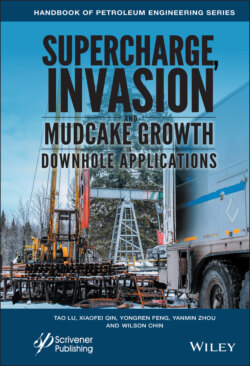Читать книгу Supercharge, Invasion, and Mudcake Growth in Downhole Applications - Группа авторов - Страница 9
Оглавление
Preface
Formation testing, unlike conventional logging methods focused on resistivity, acoustic, nuclear or magnetic resonance approaches, provides direct results as opposed to indirect inferred properties. In sampling, actual in-situ fluids are collected for surface evaluation. And in pressure transient analysis, properties that pertain to production economics like mobility, compressibility, anisotropy and pore pressure are obtained directly from the underlying Darcy flow equations. By and large, the conventional subject matter deals with single, dual and multiprobe tools where pad nozzles are displaced axially relative to each other and along the same azimuth. This being so, idealized spherical “source” or “sink” methods are used in formulating forward and inverse problems.
Even so, few models have proven useful. An early steady model for spherical flow no longer applies to the lower mobility formations encountered in practice. Later transient models contain complicated Bessel functions and integrals whose effective use in the field is questionable. And then, a rapid, early-time prediction method for “effective permeability” and pore pressure, addressing the low mobility and “not so low” flowline volume limit – while significant in the 1990s and, in fact, invented by the last author, does not address all-important supercharging effects uncovered in recent field-based publications.
Fortunately, progress in source methods has been made, but at such an unusual pace that any presentations at industry meetings would have been rapidly dated. In support of our work, John Wiley & Sons has published our research in three volumes during 2014 – 2019, introducing the latest ideas and techniques to the industry, complete with derivations, equations and software. The present work, our latest formation testing addition to Wiley-Scrivener’s Petroleum Engineering Handbook Series, serves several purposes. While “handbooks” normally refer to summaries of decades-old technologies, this edition is timely because numerous new advances have been made in related and interdependent areas. These include pressure transient analysis, forward and inverse modeling, supercharge, mudcake growth and fluid invasion formulations, and contamination and cleaning multiphase methods – and all during the past two decades by the present authors. While China Oilfield Services Limited (COSL) does manufacture its own conventional single and dual probe tools, it is the availability of our complete suite of software models that allows its tools to be used in many more innovative ways.
For example, methods are available to predict permeability and pore pressure rapidly from early time data in low mobility formations with strong flowline volume. But what if significant supercharging exists? Most inverse methods require constant flow rate drawdowns. What if this is not possible? And unacceptably, few authors have ever rigorously studied mudcake growth and fluid invasion, which produce the thick cakes responsible for stuck formation testers – the same phenomena associated with supercharge. Nor do they address the thin cakes that wreak havoc on nozzle pad sealing – leakages that would doom any formation testing job. Numerous related questions are treated in this comprehensive volume. And so this handbook, which addresses all of these problems from source model perspectives, provides unified discussions in forward and inverse formation testing analysis, supercharge in pressure evolution and permeability prediction, plus related topics in fluid invasion, mudcake growth and displacement front prediction. It is our hope that this work stimulates continuing research and enhances the innovative use of conventional tools in the field.
During the past several years, other high risk research and development projects were undertaken at COSL. In the early 1990s, an innovative “multiprobe” formation tester was introduced by a major service company that has greatly benefited the industry. This tool, consisting of an active “sink probe” and a passive “horizontal” observation probe displaced at 180° azimuthally from the sink, would provide measurements for horizontal and vertical permeability. However, in low mobility applications, measured pressure drops at the latter probe were often orders-of-magnitude less than those obtained at the pumping probe. This limitation attracted the interests of COSL engineers, who raised several unusual design challenges. “What if three azimuthally displaced probes, each separated by 120° from the others, were used?” And further, “What if each probe in the triple multiprobe tool were capable of operating independently from the others?”
What would be the logging advantages? What additional parameters of formation evaluation interest could we predict? Is it possible to detect heterogeneities? Dip angle? Can we pump at high rates without releasing dissolved gas? In order to design such a multiprobe tool, a fully three-dimensional transient model would be required to guide mechanical design as well as to support interpretation procedures at the rigsite. Can a rapid, stable, accurate and easy-to-use computational method be devised? Is it possible to develop a robust procedure that supports field work in horizontal and vertical mobility definition? How would we apply “big data” statistical approaches using advanced algorithms? Can inverse procedures be solved accurately and rapidly at the rigsite and in field offices?
These questions are addressed in a companion 2021 volume in John Wiley’s Advances in Petroleum Engineering series, entitled Multiprobe Pressure Analysis and Interpretation, by Tao Lu, Minggao Zhou, Yongren Feng, Yuqing Yang and Wilson Chin. This complementary volume contains math models entirely different from the present, but which are also applicable to conventional 180° dual probe tools. Both of our 2021 books, drawing on research and engineering developed over more than a decade, are essential to modern formation testing, and we hope that both will find permanent places on petroleum engineers’ bookshelves. In this time of great uncertainty, one truth prevails: now, more than ever, innovation is needed to explore and produce natural resources more efficiently. And innovation in engineering means nothing less than a thorough understanding of physics and mathematics and putting both to important practical use.
The Authors,
Beijing and Houston
